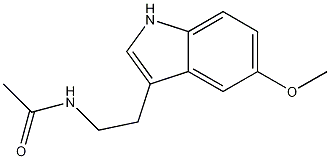CHEMICAL AND PHYSICAL PROPERTIES
| Physical Description | Solid |
|---|---|
| Color/Form | Pale yellow leaflets from benzene |
| Melting Point | 117 °C |
| Solubility | >34.8 [ug/mL] (The mean of the results at pH 7.4) |
| LogP | 1.6 |
| Dissociation Constants | Melatonin has pKa of 16.51 and -0.69 and is uncharged in the entire pH-range |
| Collision Cross Section | 154.3 Ų [M+H]+ [CCS Type: DT, Method: single field calibrated with Agilent tune mix (Agilent)] |
| Kovats Retention Index | 2451.9 |
| Other Experimental Properties | log Kow = 1.2 |
COMPUTED DESCRIPTORS
| Molecular Weight | 232.28 g/mol |
|---|---|
| XLogP3 | 0.8 |
| Hydrogen Bond Donor Count | 2 |
| Hydrogen Bond Acceptor Count | 2 |
| Rotatable Bond Count | 4 |
| Exact Mass | 232.121177757 g/mol |
| Monoisotopic Mass | 232.121177757 g/mol |
| Topological Polar Surface Area | 54.1 Ų |
| Heavy Atom Count | 17 |
| Formal Charge | 0 |
| Complexity | 270 |
| Isotope Atom Count | 0 |
| Defined Atom Stereocenter Count | 0 |
| Undefined Atom Stereocenter Count | 0 |
| Defined Bond Stereocenter Count | 0 |
| Undefined Bond Stereocenter Count | 0 |
| Covalently-Bonded Unit Count | 1 |
| Compound Is Canonicalized | Yes |
PRODUCT INTRODUCTION
description
Melatonin is a member of the class of acetamides that is acetamide in which one of the hydrogens attached to the nitrogen atom is replaced by a 2-(5-methoxy-1H-indol-3-yl)ethyl group. It is a hormone secreted by the pineal gland in humans. It has a role as a hormone, an anticonvulsant, an immunological adjuvant, a radical scavenger, a central nervous system depressant, a human metabolite, a mouse metabolite and a geroprotector. It is a member of acetamides and a member of tryptamines. It is functionally related to a tryptamine.
